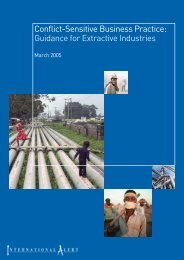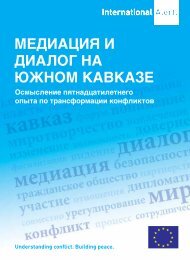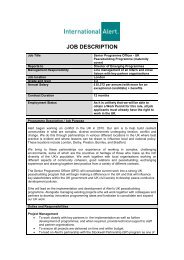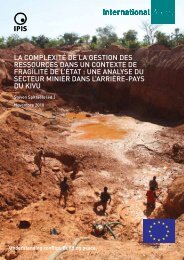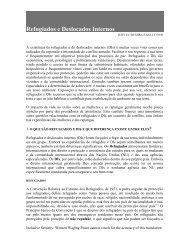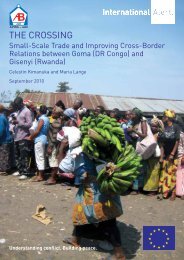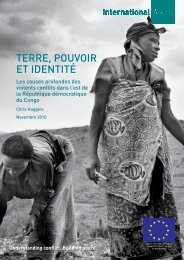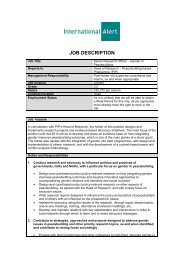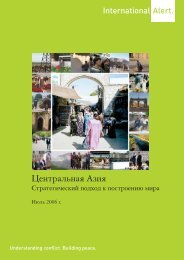18 International AlertTable 4: Elements of a vision for future <strong>peace</strong>?Illustrating what might emerge from <strong>peace</strong> visioning processes in South Sudan <strong>and</strong> SudanShared vision of <strong>peace</strong>FactorPossible future goals (2012-2016 <strong>and</strong> beyond)Power Economy Fairness,equality <strong>and</strong>justice• Oppositionparties <strong>and</strong>other groups donot feel unjustlyexcluded frompower• Elections arebecoming morerooted in thepolitical system• Women areplaying astronger role inpolitics locally<strong>and</strong> nationally• Government<strong>and</strong> politicalparties propose<strong>and</strong> implementpolicies whichserve widernationalinterests,rather thanthe interests ofnarrow groups• Investment <strong>and</strong>economic growthare more evenlydistributed, <strong>and</strong>infrastructure inpoorer regions isimproving• Economicdevelopment<strong>and</strong> growthstrengthen<strong>peace</strong>, ratherthan causing orexacerbatingeconomic <strong>and</strong>political tensionswhich may leadto violent conflict• Public needsor wishesfor truth <strong>and</strong>reconciliation arebeing met• Greater publicconfidence in thelaw <strong>and</strong> formaljustice system• Property rightsare clearer<strong>and</strong> are upheldin a just <strong>and</strong>equitable mannerSafety• Violent conflictbetweengovernment<strong>and</strong> antigovernmentforces,<strong>and</strong> intercommunalviolence aredecliningespecially inDarfur, SouthKordofan <strong>and</strong>key states inSouth Sudan,<strong>and</strong> betweenthe twocountries• The public hasmore trust <strong>and</strong>confidence inthe securityforces <strong>and</strong>rule of law,<strong>and</strong> privateownershipof guns isdecliningWell-being• Basic services areprovided moreequitably acrossgeographic, ethnic<strong>and</strong> gender lines• Marginalisation <strong>and</strong>discrimination aredeclining• People feel that theirfreedom <strong>and</strong> dignityare respectedUnderlying issues where changes are likely to be neededDiscrimination, inequality, injusticeCorruption, economy, oilDistrust, patronage, reconciliationIdeology, identity, tribalismLeadership, political parties, religionRole of the military, armed groups <strong>and</strong> international actorsFinding new approachesAs <strong>peace</strong>building theories <strong>and</strong> practice indicate, <strong>and</strong> as Alert has found in its experience indifferent countries, the approach or process by which a shared vision of <strong>peace</strong> is developed isas important as the vision itself, or even more so. In all cases, dialogue is central to developinga shared vision, but there are many forms which dialogue can take. One approach is sustaineddialogue, for example through a process of mid- to high-level dialogue bringing together peoplefrom government, politics, the opposition, religious <strong>and</strong> traditional authorities, civil societyorganisations, business, <strong>and</strong> other walks of life. Such dialogue may be replicated in different partsof a country <strong>and</strong> may be organised so that ideas <strong>and</strong> recommendations are brought together into a
<strong>What</strong> <strong>peace</strong> <strong>and</strong> whose?19subsequent dialogue forum, such as a national reconciliation conference or a constitutional reviewconference. Another approach can be dialogue among narrower groups, focusing on the <strong>peace</strong>vision for a particular part of the country or a particular theme or issue, such as the economy ortruth <strong>and</strong> reconciliation.In all cases, <strong>peace</strong>building dialogue is an opportunity for participants to moveaway from current positions or short-term concerns – about which they may bein disagreement – <strong>and</strong> to discuss longer-term ideas <strong>and</strong> issues about which theymay not have a fixed position. Conducted well, such dialogue can:• Bring people together who would otherwise not come together, <strong>and</strong> discussissues which might otherwise seem off-limits;• Allow those who think they know what others think <strong>and</strong> st<strong>and</strong> for (whattheir positions are) to discover that they have more interests in common witheach other than they had thought;• Provide an opportunity for participants to look at issues afresh, as freethinkingindividuals, because they participate as individuals, rather thanrepresentatives;• Stimulate participants to take the insights gained during the dialogue awaywith them into their normal everyday roles, <strong>and</strong> to continue the dialoguewith others <strong>and</strong> to initiate new actions they would not otherwise have done.‘It is incumbenton the leadershipsof the north <strong>and</strong>the south to worktogether to avoidhostilities <strong>and</strong> tobring benefits to thepeople of the north<strong>and</strong> the south.’Lazaro Sumbeiywo, chief mediator<strong>and</strong> chair of CPA <strong>peace</strong> talks,speech, May 2011Box 4: <strong>What</strong> is <strong>peace</strong>building?“Peacebuilding” covers a broad set of processes <strong>and</strong> actions by any party with the capacity to influencethe prospects for <strong>peace</strong>. <strong>What</strong> sets <strong>peace</strong>building aside from other processes (such as development,economic growth, <strong>and</strong> humanitarian aid) is simply that it is done with the express purpose of buildinglasting <strong>peace</strong>, <strong>and</strong> is based on as complete an underst<strong>and</strong>ing as possible of the factors that contributeto or prevent <strong>peace</strong>.In short, <strong>peace</strong>building is the set of processes whose purpose is to gain, maintain <strong>and</strong> strengthen<strong>peace</strong>. This means activities <strong>and</strong> interventions which are designed to influence events, processes <strong>and</strong>actors to create new outcomes, so that <strong>peace</strong>ful conditions are gained <strong>and</strong>/or maintained. This is alarger goal than simply preventing or stopping violence, or resolving conflicts.Peacebuilding in South Sudan <strong>and</strong> SudanIn developing a shared vision for <strong>peace</strong> in South Sudan <strong>and</strong> Sudan, <strong>and</strong> finding approaches <strong>and</strong>methods which will be effective, it can be helpful to ask questions <strong>and</strong> to identify some principlesfor <strong>peace</strong>building. For example:• Who is responsible for <strong>peace</strong> in South Sudan <strong>and</strong> Sudan?• Who needs to be involved for a deeper, more stable <strong>peace</strong> to be built?• <strong>What</strong> needs to change in existing attitudes <strong>and</strong> approaches to <strong>peace</strong>building?• If the same approaches are taken as before, why <strong>and</strong> how will the results be different?• <strong>What</strong> can be learned from examples elsewhere?• If different approaches are taken, what approaches <strong>and</strong> actions are best?Answers to these questions should come first <strong>and</strong> foremost from within South Sudan <strong>and</strong> Sudan,for example as part of dialogue <strong>and</strong> discussion which leads to a statement of principles for<strong>peace</strong>building. (In a similar way, declarations of principles emerged from Sudan’s many <strong>peace</strong> talksin the past <strong>and</strong> became foundations of <strong>peace</strong> processes.) However, considering the history <strong>and</strong>





